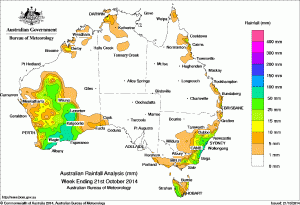Rainfall for the past week was recorded in Western Australia, isolated pockets of the Northern Territory, parts of coastal Queensland, eastern New South Wales, eastern Victoria and western and northeastern Tasmania.
At the start of the week, a slow-moving low pressure system intensified near the New South Wales coast, bringing heavy rainfall along the southern coast of New South Wales, with moderate falls also recorded in East Gippsland in Victoria.
During the middle of the week, a cold front tracked through southeast Australia bringing light falls to eastern Victoria, southeastern New South Wales and western Tasmania.
In the west, a broad low pressure system interacted with a middle level disturbance and generated moderate rainfall totals through southern and central Western Australia, with heavier falls reported on parts of the south coast from mid-week.
At the end of the week, a cold front crossed southern Victoria and Tasmania producing moderate rainfall totals in western and northeastern Tasmania, while showers formed in isolated parts of east coast Queensland and New South Wales in a moist, onshore airflow.
Rainfall totals over 100 mm were reported in parts of the South Coast and Sydney Metropolitan districts of New South Wales, along with some isolated spots in the Central and South Coast districts of Western Australia. The highest weekly total was 164 mm at Ulladulla in New South Wales.
Rainfall totals between 50 mm and 100 mm were recorded in a large part of southern Western Australia and in areas surrounding higher falls along the southern coast of New South Wales.
Rainfall totals between 15 mm and 50 mm were broadly recorded in southern Western Australia extending north into the Eastern Gascoyne district, and in parts of West and East Gippsland in Victoria, parts of the northeast, south and west coast of Tasmania, and isolated parts of the tropical north and southeast coasts of Queensland.
Rainfall totals between 10 mm and 15 mm were recorded surrounding higher falls in central and southern Western Australia, eastern Victoria, western and northeastern Tasmania, southeastern New South Wales, pockets of Queensland’s east coast, isolated spots in the Northern Territory, and parts of the Kimberley in far north Western Australia.
Much of inland Western Australia and the Gascoyne, South Australia, most of the Northern Territory and Queensland away from the coast, inland New South Wales and western Victoria recorded little or no rainfall for the week.
Highest weekly total in each State:
| State | Highest | 2nd Highest | 3rd Highest |
|---|---|---|---|
| WA | Ravensthorpe (109 mm) (South Central) |
Porongurups (105 mm) (South Coast) |
Telina Downs (99 mm) (South Coast) |
| NT | Charles Point (35 mm) (Darwin-Daly) |
Territory Wildlife Park (22 mm) (Darwin-Daly) |
Pinelands (22 mm) (Darwin-Daly) |
| SA | Millicent (9 mm) (Lower Southeast) |
Mount Gambier (8 mm) (Lower Southeast) |
Lake George (6 mm) (Lower Southeast) |
| Qld | Lady Elliot Island (35 mm) (Port Curtis) |
Babinda Post Office (33 mm) (Barron) |
Mt Sophia (31 mm) (Barron) |
| NSW/ACT | Ulladulla (164 mm) (South Coast) |
Cronulla South (154 mm) (Metropolitan) |
San Souci (144 mm) (Metropolitan) |
| Vic | Reeves Knob (59 mm) (West Gippsland) |
Mount Wellington (56 mm) (West Gippsland) |
Mount Tamboritha (40 mm) (West Gippsland) |
| Tas | Mount Read (47 mm) (West Coast) |
Lake Margaret (36 mm) (West Coast) |
Queenstown (34 mm) (West Coast) |
Source: BOM


HAVE YOUR SAY